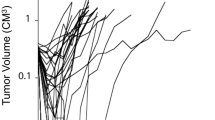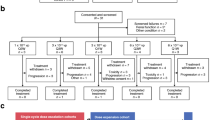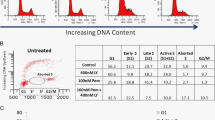Abstract
XK-469 is advancing to Phase I clinicaltrials. Preclinical studies were carriedout to assist in clinical applications.Dose-schedule route testing: Singledose IV treatment with XK-469 producedlethality (LD20 to LD 100) above 142 mg/kg.Optimum treatment required total dosages of350 to 600 mg/kg. Furthermore, highindividual IV dosages (100 to 142 mg/kg)were poorly tolerated, producingsubstantial weight loss (8 to 18% of bodyweight), poor appearance, and slow recovery(8 to 12 days). A 1-hour infusion ofdosages more than 140 mg/kg, or BIDinjections 6 hrs apart, did not reducelethality. However, lower individualdosages of 40 to 50 mg/kg/injection IV werewell tolerated and could be given daily toreach an optimum total dose with minimaltoxicities. Likewise, 75 mg/kg/injection IVcould be used every other day to reachoptimal treatment. The necropsy profiles ofdeaths from toxic dosages were essentiallyidentical regardless of schedule (deaths 4to 7 days post treatment). The profileswere: paralytic ileus or gastroparesis; GIepithelial damage; and marrow toxicity.Interestingly, the key lethal events wererapidly reversible and simple to overcomewith lower dosages given daily or everyother day. Based on these results, the highdose, Q21day schedule should be avoided inclinical applications. Instead, a splitdose regimen is recommended (e.g., daily,every other day, or twice weekly). XK-469was also well tolerated by the oral route,requiring 35% higher dosages PO to reachthe same efficacy and toxicity as producedIV. Cross-resistance studies: XK-469resistance was produced by optimumtreatments of IV implanted L1210 leukemiaover seven passage generations. Thisleukemia subline (L1210/XK469) had reducedsensitivity to VP-16 (with a 4.0 log killin IV implanted L1210/XK469 compared to an8.0 log kill against IV implanted L1210/0). It also had a reduction in the sensitivityto 5-FU (with a 2.0 log kill in theimplanted L1210/XK469 compared to a 4.0 logkill against IV implanted L1210/0). Otheragents were approximately as active againstthe resistant tumor, including: Ara-C,Gemzar, Cytoxan, BCNU, DTIC, and CisDDPT. No case of collateral sensitivity wasobserved; i.e., no agent was markedly moreactive against the resistant sublineL1210/XK-469 than against the parent tumorin mice.
Similar content being viewed by others
References
Corbett T, Valeriote F, LoRusso P, Polin L, Panchapor C, Pugh S, White K, Knight J, Demchik L, Jones J, Jones L, Lowichik N, Biernat L, Foster B, Wozniak A, Lisow L, Valdivieso M, Baker L, Leopold W, Sebolt J, Bissery MC, Mattes K, Dzubow J, Rake J, Perni R, Wentland M, Coughlin S, Shaw JM, Liversidge G, Liversidge E, Bruno J, Sarpotdar P, Moore R, Patterson G: Tumor models and the discovery and secondary evaluation of solid tumor active agents. Int J of Pharmacognosy (Suppl) 33: 102–122, 1995
Corbett TH, LoRusso P, Demchik L, Simpson C, Pugh S, White K, Kushner J, Polin L, Meyer J, Czarnecki J, Heilbrun L, Horwitz JP, Gross JL, Behrens CH, Harrison BA, McRipley RJ, Trainor G: Preclinical antitumor efficacy of analogs of XK-469: Sodium-(2-[4-(7-chloro-2-quinoxalinyloxy)phenoxy] propionate. Invest New Drugs 16: 129–139, 1998
LoRusso PM, Parchment R, Demchik L, Knight J, Polin L, Dzubow J, Behrens C, Harrison BA, Trainor G, Corbett TH: Preclinical antitumor activity of XK469 (NSC656889). Invest New Drugs 16: 287–296, 1999
Gao H, Huang KC, Yamasaki EF, Chan KK, Chohan L, Snapka RM: XK469, a selective topoisomerase II beta poison. Proc Nat Acad Sci USA 96(21): 12168–12173, 1999
Schabel FM Jr, Trader MW, Laster WR Jr, Corbett TH, Griswold DP Jr: Cis-dichlorodiammineplatinum (II): Combination chemotherapy and cross-resistance studies with tumors of mice. Cancer Treat Rep 63: 1459–1473, 1979
Schabel FM Jr, Skipper HE, Trader MW, Laster WR Jr, Griswold DP Jr, Corbett TH: Establishment of cross-resistance profiles for new agents. Cancer Treat Rep 67: 905–922, 1983
Corbett TH, Valeriote FA: Rodent models in experimental chemotherapy. In: Kallman RF (ed) Rodent Tumor Models in Experimental Cancer Therapy. Pergamon Press, New York, 1987, Chap 50, pp 233–247
Corbett TH, Bissery MC, LoRusso PM, Polin L: 5-Fluorouracil containing combinations in murine tumor systems. Invest New Drugs 7: 37–49, 1989
Corbett TH, Valeriote FA, Baker LH: Is the P388 murine tumor no longer adequate as a drug discovery model? Invest New Drugs, 5(1): 3–20, 1987
Corbett T, Valeriote F, LoRusso P, Polin L, Panchapor C, Pugh S, White K, Knight J, Demchik L, Jones J, Jones L, Lisow L: In vivo methods for screening and preclinical testing; Use of rodent solid tumors for drug discovery. In: Teicher B (ed) Anticancer Drugs Development Guide: Preclinical Screening, Clinical Trials, and Approval. Humana Press Inc, Totowa, New Jersey, 1997, Chap 5, pp 75–99, 1997
Polin L, Valeriote F, White K, Panchapor C, Pugh S, Knight J, LoRusso P, Hussain M, Liversidge E, Shaw M, Golakoti T, Patterson G, Moore R, Corbett TH: Treatment of human prostate tumors PC-3 and TSU-PR1 with standard and investigational agents in scid mice. Invest New Drugs 15: 99–108, 1997
Corbett TH, Panchapor C, Polin L, Lowichik N, Pugh S, White K, Kushner J, Meyer J, Czarnecki J, Chinnukroh S, Edelstein M, LoRusso P, Horwitz JP, Grieshaber C, Perni R, Wentland M, Coughlin S, Elenbaas S, Philion R, Rake J: Preclinical efficacy of thioxanthone SR-271425 against transplanted solid tumors of mouse and human origin. Invest New Drugs 17: 17–27, 1999
Tosca PJ, Turner NA, Hassler CR, Ryan MJ, Yarrington J, Bollinger LH, Long HA, Schweikart KM, Tomaszewski JE: Toxicity of R(+) XK469 (NSC-698215) and S(-) XK469 (NSC-698216) in rodents and beagle dogs. American Association of Cancer Research 91st Annual Meeting, San Francisco, CA, April 1–5, 2000, Proc AACR 41: Abst: 4480, 2000, p705
Author information
Authors and Affiliations
Rights and permissions
About this article
Cite this article
Polin, L., White, K., Kushner, J. et al. Preclinical Efficacy Evaluations of XK-469: Dose Schedule, Route and Cross-Resistance Behavior in Tumor Bearing Mice. Invest New Drugs 20, 13–22 (2002). https://doi.org/10.1023/A:1014469828729
Issue Date:
DOI: https://doi.org/10.1023/A:1014469828729




